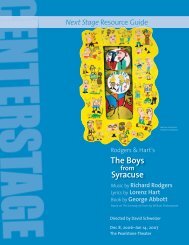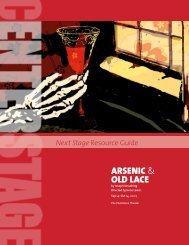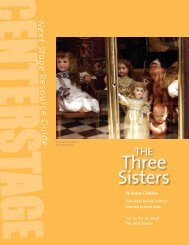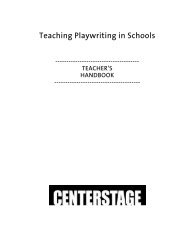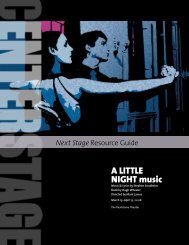The Artistic TeamDirectorDavid SchweizerScenic DesignerJames NooneCostume DesignerDavid BurdickLighting DesignerAlexander NicholsSound DesignerMark BennettSpeech ConsultantGillian Lane-PlesciaChoreographerMichael J. BobbittProduction DramaturgLiana ThompsonCasting DirectorJudy DennisAssistant DirectorAdrian WattenmakerThe castGerte CrumpPatricia Ageheim*Ermina CrumpEdwina Findley*Godfrey CrumpLeLand Gantt*Ernestine CrumpAmina S. Robinson*Lily Ann GreenKelly Taffe*<strong>Stage</strong> ManagerMike Schleifer*Assistant <strong>Stage</strong> ManagerLauren Wright*settingBrooklyn, 1950Running time is approximately2 hours, including one15-minute intermission.*Member of Actors’ Equity Association,the Union of Professional Actors and<strong>Stage</strong> Managers in the United Statesne\TstageCrumbs from the Table of Joy May 5–June 11, 2006700 North Calvert StreetBaltimore, MD 21202Artistic Director Irene LewisManaging Director Michael RossArt Director Bill GeenenGraphic Designers Dina Epshteyn,Jason GembickiEditors Aaron Heinsman, SteveLichtensteinContributors Steve Lichtenstein,Otis Ramsey-Zöe, Liana ThompsonCorporate Support The Black &Decker Corporation, CitiFinancial andCitigroup Foundation, DLA PiperRudnick Gray Cary US LLP, Legg Mason,Inc., M&T Bank, Procter & GambleCosmetics Foundation, Provident Bank,T. Rowe Price Associates Foundation,Inc., Target Stores, Verizon, Wal-Mart,Washington GasFoundation & INDIVIDUAL SupportAnonymous, The Helen P. DenitCharitable Trust, The Family Leagueof Baltimore City, Inc., The GoldsmithFamily Foundation, Lockart VaughanFoundation, The Macht PhilanthropicFund, The Nellie Mae EducationFoundation, Jeanne Murphy, The Jim &Patty Rouse Charitable Foundation, TheSheridan Foundation, The Aaron Straus& Lillie Straus Foundation, VSA arts andMetLife FoundationCover: Photo of Amina S. Robinson andEdwina Findley by Richard AndersonAdvertisements reprinted from LIFEmagazine.If you have any trouble usingthis study guide—or for moreinformation on CENTERSTAGE’seducation programs—call us at410.986.4050. Student group ratesstart at just $15. Call Group Sales at410.986.4008 for more information.Or visit www.centerstage.org.Material in our Next <strong>Stage</strong> studyguide is made available free ofcharge for legitimate educational andresearch purposes only. Selectiveuse has been made of previouslypublished information and imageswhose inclusion here does notconstitute license for any further reuseof any kind. All other materialis the property of CENTERSTAGE,and no copies or reproductions ofthis material should be made forfurther distribution, other thanfor educational purposes, withoutexpress permission from the authorsand CENTERSTAGE.2234568101618c o n t e n t sThe Artistic TeamThe CastSetting the <strong>Stage</strong>About the Playwright:Lynn NottageGlossaryReality and Fantasy1950People and Thingsfrom the 1950sDivine FaithActivitiesNEXTSTAGE | Crumbs from the Table of Joy
This is the story of Ernestine Crump. At17, her world has been radically—andurgently—transformed: her mother hasdied; her father, Godfrey, has found solace ina religious leader; and the family has uprootedfrom Florida to a cramped basement apartmentin Brooklyn, where the arrival of a Black familyis hardly cause for celebration. Her youngersister, Ermina, is meddlesome and sassy, andher flirtatious and somewhat dipsomaniacalAunt Lily enjoys antagonizing Godfrey andproclaims her Communism. And Ernestine’snew stepmother: the caring, desperate-forapprovalGerte? She’s white. And German.Each Crump deals with loss and change in adifferent way. Ermina discovers boys. Lilymoves into the apartment with an intoxicatingwhirlwind of booze and cigarettes, streetwisdom, and indignation. Godfrey joins thechurch of Father Divine, to whom he sends hismost important questions concerning salvationand faith. He also meets German immigrantGerte on the train one day and decides almostimmediately to marry her, much to the chagrinof the other Crumps. But amidst all the chaosaround her—both inside her house and out—Ernestine knows that “something better is alwayson the horizon.” In her case, the horizon holdsher upcoming graduation from high school andthe allure and escapism of Hollywood pictures,Joan Crawford and John Garfield in Humoresque (1946)S e t ting the S t ag eBy Steve Lichtensteinparticularly the statuesque screen divas whoseglamorous dress and elegant names so beguileher.Ernestine also finds time to narrate her family’sstory. As she stands on the cusp of adulthood,Lynn Nottage’s Crumbs from the Table of Joydepicts a nation caught between the need forself-improvement and the comfort of stagnation.Set in 1950, Nottage’s play shows the Crumpsin a US stuck in a grey area of uncertainracial tension—before either Brown v. Boardof Education or a formidable Civil Rightsmovement—where old racist notions gave wayto either uneasy guilt or wanton aggression.In addition, the insular paranoia of thepre-McCarthy era—of Communists in our midstand the enemy next door—resulted in a timewhen everyone was suspect. Crumbs from theTable of Joy wryly portrays a family forced toconfront the expectations and prejudices of theworld around them, come to terms with their ownbiases and insecurities, and deal with how theirrelationships are affected by a shifting nationalconscience. Can Ernestine and Ermina deal withthe social stigma of a white, foreign stepmother?Can faith and religion satisfy the pangs of lossand racism? Can the Crumps survive in a whiteworld? Will Ernestine discover her place in theworld?NEXTSTAGE | Crumbs from the Table of Joy



